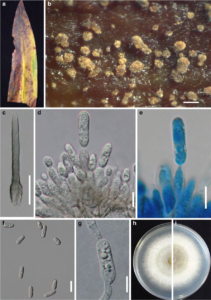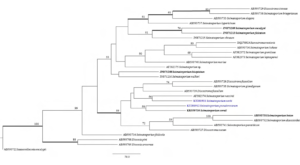Colletotrichum hymenocallidicola Chethana, Tangthir., Wijayaw. & K.D. Hyde, in Ariyawansa et al., Fungal Diversity: 10.1007/s13225-015-0346-5, [134] (2015)
Index Fungorum number: IF551304; Facesoffungi number: FoF: 00870
Etymology – The specific epithet hymenocallidicola is named after the host Hymenocallis from which the taxon was collected.
Holotype – MFLU 13–0292
Pathogenic on leaves. Sexual morph: Undetermined. Asexual morph: Conidiomata 100–130 μm (x̄ = 116 μm, n=10) diam., solitary, an acervulus, black, oval. Setae 51– 56 μm long, pale to dark brown, smooth-walled to verruculose, straight, 1–3-septate, base cylindrical, 2–4 μm diam., apex acute to roundish. Conidiogenous cells 10–20× 3–5 μm (x̄ = 13×4 μm, n=20), enteroblastic, hyaline, smooth-walled, cylindrical to clavate, collarette not visible. Conidia 11–19×4–6 μm (x̄ = 16×5 μm, n=20), hyaline, cylindrical, aseptate, slightly curved, with rounded ends, guttulate, smooth-walled, L/W ratio 3.2. Appresoria not observed.
Cultural characteristics: Conidia germinating on water agar mostly from both ends. Colonies on PDA, edge entire, white to pale white, dense, cottony mycelium on the surface and reverse with pale white mycelium.
Material examined – THAILAND, Phang Nga, on a living leaf of Hymenocallis sp. (Amaryllidaceae), 3 August 2012, Narumon Tangthirasunun NTCL99 (MFLU 13–0292, holotype); ex-type living cultures, MFLUCC 12–0531, KUMCC 15–0076, CFTCC 15–0003.
Notes – Based on phylogenetic analyses and morphological comparison, our isolate belongs to Colletotrichum.
Colletotrichum hymenocallidicola appears as a singleton species and forms a sister clade (Fig. 1) to C. brevisporum Noireung et al. (BCC 38876) with high bootstrap support (100 %) and Bayesian posterior probabilities (1.00). Colletotrichum brevisporum differs from C. hymenocallidicola in their smaller conidia (12–17×5– 6 μm, L/Wratio 2.52) and fewer guttules. Original description of C. brevisporum does not contain setae characters (Noireung et al. 2012).

Fig. 1 Colletotrichum hymenocallidicola (holotype) a Specimen with conidiomata b Black acervuli on host c Light brown setae d, e Hyaline conidiogenous cells f Hyaline conidia g Germinating conidium h Upper view of the colony i Reverse view of the colony. Scale bars: b=100 μm, c, f=20 μm, d, e=10 μm, g=5 μm

Fig. 2 Phylogram generated from Maximum Parsimony (MP) analysis based on combined LSU and ITS sequence data of Seimatosporium species. Maximum parsimony bootstrap support values greater than 50 % are indicated above the nodes, and branches with Bayesian posterior probabilities greater than 0.95 are given in bold. The ex-type strains are in bold; the new isolates are in blue. The tree is rooted with Immersidiscosia eucalypti (AB593722). We used GenBank accession numbers of LSU sequence data instead of culture collection numbers as most of the strains only have accession numbers. The tree is based on
species in (Barber et al. 2011)
